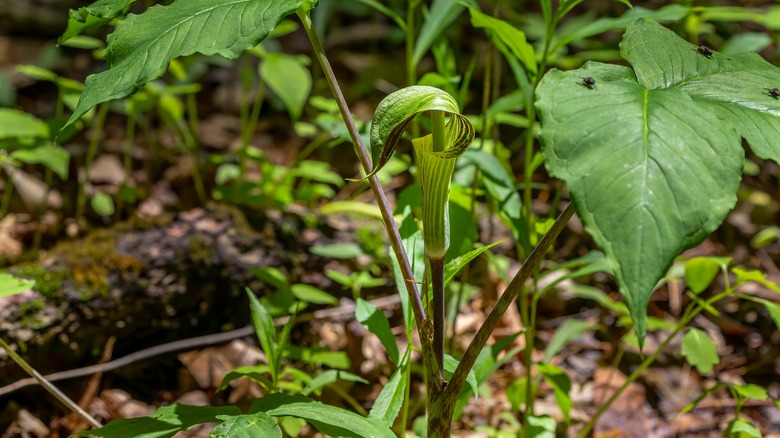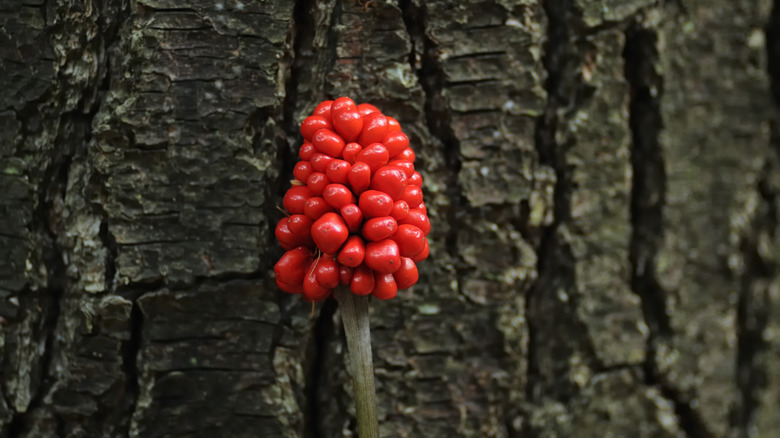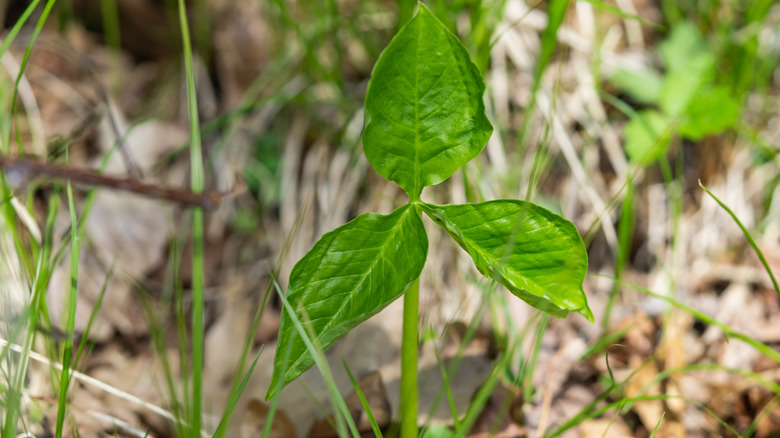Jack-In-The-Pulpit: The Beautiful Flowering Plant You Need To Know About
If you're creating a shade, understory native, or rain garden in your backyard, the perennial Jack-in-the-pulpit (Arisaema triphyllum) is a must-have addition. It's best suited, however, to only the most patient of gardeners. Much of the action takes place underground in the plant's early years. A germinated Jack seed sends up a long leaf stalk — three leaflets to a leaf — to collect energy from the limited sun that reaches its preferred shady, damp growing spot. This it stores in its slow-developing corm — a bulbous subterranean stem. After five years of optimal growth from seed, male flowers appear between March and June, followed a few years later by female blooms. Each inflorescence (group of flowers) has a spathe (the "pulpit") and a flower-studded spadix (the "Jack").
The plant continues on like this, its reproductive capabilities uniquely waxing and waning as environmental conditions improve or decline, for up to a century in the most ideal of situations — but at least 25 or more years in a garden setting. During this time, the Jack-in-the-pulpit slowly expands through animal-dispersed seeds and spreading rhizomes. Despite its lackadaisical growth habits, it's extremely hardy in the wild and backyards alike, thriving in deep shade and bog-like conditions across eastern North America. Similarly to its famous cousin, the immense and stinky corpse flower, the Jack is pollinated by flies — specifically fungus gnats — that the plant attracts and subsequently traps (in the case of the female flowers, at least) with a mushroomy scent.
Jack-in-the-pulpit in the wild
Most herbivorous insects leave Jack-in-the-pulpit well alone, perhaps due to the skin and tongue-tingling calcium oxalate crystals every part of the plant contains in abundance. Humans are highly discouraged from eating any part of Jack-in-the-pulpit raw as it can cause significant swelling, blisters, and burning in the mouth and throat, per Mount Sinai. Deer and bears feast on the plants when other options have been exhausted while birds nibble the bright-red-when-ripe berries that appear in late summer.
Jack seeds are easy to collect from wild plants. Head out in late fall, looking for the distinctive bright red cluster of berries. Don gloves before you pick the bunch to avoid skin irritation. Once home again, smash the berries with a spoon and remove the seeds. Keep them moist — they won't be viable if they dry out. Stratify the seeds by placing them in the fridge inside a sealable plastic bag or container filled with damp potting mix for two to three months. Plant the cold-chilled seeds out into seedling containers for later transplantation or the ground in the early spring. If you want to enhance rather than remove a shade tree from your yard, you're in luck. A stand of Jacks will thrive in even the darkest and dankest parts of your garden. Simply scatter the seeds in the area you want the plant to grow.
Growing Jack-in-the-pulpit
Not interested in rummaging through local forestland for seeds in the chilly late fall? Native Wildflowers Nursery sells three bulbs (or corms) of this iconic native plant for $14.97. Similarly, you can buy three bulbs from native specialist growers American Meadows for $14.99. Walmart has 20 bulbs for $47.41, and Prairie Future Seed Company offers a packet of eight seeds for $3.25. Keep in mind the Jack-in-the-pulpit goes by other common names, like Indian turnip, bog onion, and brown dragon; consider using these names in your search. Remember, too, that there are three species of Jack-in-the-pulpit in the U.S.: Arisaema triphyllum, Arisaema triphyllum "pusillum," and Arisaema triphyllum "triphyllum." They all share the same growing conditions and look similar, though Arisaema triphyllum has a purple-brown spathe. What you choose to grow comes down to availability and personal preference.
Before you pop your Jack seeds, corms, or seedlings in the ground, consider whether you have a place in the garden with the right conditions. Jack-in-the-pulpit grows in USDA Hardiness Zones 4 to 9 and is best planted under deciduous trees offering dappled to complete shade across the seasons. It likes a lot of water — think quick-draining swampiness — and prefers heavily fertile over clay soils. Once your stand grows large enough, divide the plants in the fall when the leaves have died back and transplant the corms to other parts of your yard, burying them 2 to 4 inches.


